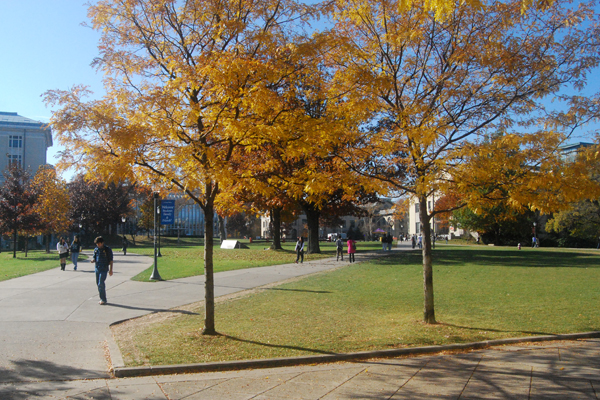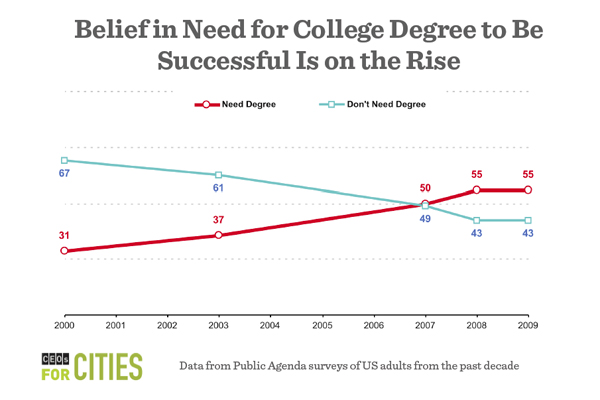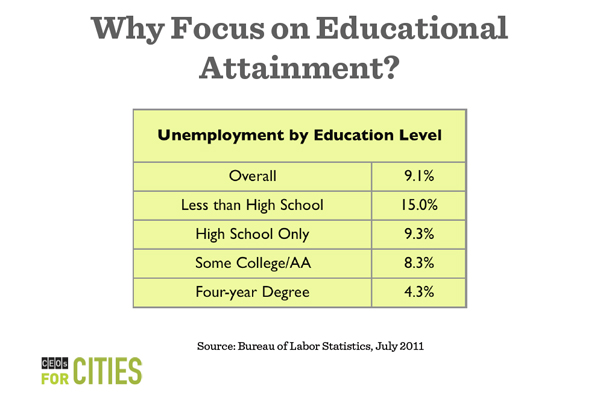The Talent Dividend: How more college grads can add to Cincinnati’s bottom line
What's the best thing a city can do to achieve more economic success? Increase its number of college graduates. The most prosperous cities have the highest number of college grads. Read how the Talent Dividend calculates just how much college degrees add to a city's bottom line — think billions.
What if Cincinnati could attract a company that generated revenues of a billion or more? Think along the lines of megabank PNC or a sizzler of a tech company like Facebook.
The Talent Dividend, an initiative out of CEOs for Cities, calculates how even a 1 percent increase in a city’s population of college graduates results in great economic boosts. In Philadelphia, it’s $4.4 billion. In Baltimore, it’s $2 billion. In Tampa Bay, more than $3 billion.
The more educated the city, the more robust its economy, reports Joe Cortwright, author of the study. The percentage of college graduates in a city’s population accounts for 58 percent of a city’s economic success, as measured by per capita income. From Austin to D.C., the most successful cities have the highest number of college grads.
“The best way to measure the economic success of a city is per capita income and the simple most direct connection of per capita income is college attainment,” says Lee Fisher, president of CEOs for Cities, a civic lab and network of urban leaders across the country.
A better-educated workforce results in higher incomes and higher productivity and skills, contributing to the overall health of cities. But there’s even more at stake for society, as New York Times columnist David Brooks recently argued.
In writing about the polarization of our country, Brooks says, “the crucial inequality is not between the top 1 percent and the bottom 99 percent. It’s between those with a college degree and those without. “Over the past several decades,” he writes, “the economic benefits of education have steadily risen. In 1979, the average college graduate made 38 percent more than the average high school graduate, according to the Fed chairman, Ben Bernanke. Now the average college graduate makes more than 75 percent more.”
In the 1970s, high school and college grads had very similar family structures, he continues. Today, college grads are much more likely to get married and be active in their communities, and much less likely to smoke, be obese or have a child out of wedlock. The best thing we can do for our country, declared President Obama in a recent jobs report speech, is invest in ourselves and the best way to do that is to get more of our citizens graduated from college. Increasing college attainment by one percentage point in each of the 51 largest metropolitan areas would be associated with an increase in personal income of $124 billion per year for the U.S, according to the Talent Dividend research.
A matter of degree
How many of us hold four-year degrees? Nationally it’s around 30 percent while in Cincinnati, it’s 25 percent, according to Talent Dividend Metrics.
Good magazine reports that while 60 percent of jobs today require at least a two-year college degree, only 40 percent of Americans attain a two or four year degree by the age of 27. And another rather discouraging stat: only 56 percent of college-goers earn a four-year degree within six years, making for a low on-time completion rate.
What can a city do? Cincinnati’s Strive, a three-year old “unified cradle to career vision” with corresponding goals for education improvements, coordinates existing resources and build on what works. The city’s ranking as the top urban school district in the state of Ohio points to promising early results from the collaborative efforts between schools, businesses and non-profits to create innovative and measurable solutions to long-term, ongoing problems. The launch of tweducate.org earlier this year illustrates the collective impact of schools, nonprofits and businesses working together to attract, inspire and retain talented educators to our region. Combining practical tools with success stories helps our communities not only reshape narratives but also build upon and celebrate successes throughout the region.
But we don’t have to stop there. We can also look at strategies from other competitive cities, which is exactly what is happening thanks to the National Talent Dividend Network, which met in Cincinnati last fall and includes 20 major U.S. cities. In Memphis, they’re going after low-hanging fruit, conducting a series of back to school workshops for working adults with some college to complete their degrees, including financial guidance on how to pay for it.
Leadership Memphis is involved as part of its mission to increase citizens IQs through learning or action and the Memphis Talent Dividend website invites citizens to donate, get involved and submit their own ideas on how to help—from even the smallest of gestures such as babysitting for someone attending class.
In Oklahoma City, Close the Deal brings mayors and CEOs into high schools to meet with seniors in a two-prong strategy: to tell them know how much it matters that they strive for a college degree and—a proven strategy—to urge them to complete free applications for federal student aid (FAFSA). It’s working. In schools they have visited, FAFSA apps are way up. That matters because of the 48 percent of graduating seniors who take the FAFSA form, 80 percent go to college, according to FAFSA.
In Pittsburgh, they’re banking on more community support around the Pittsburgh Promise, a college scholarship program for qualified city students based on grade point average and attendance and worth up to $40,000 per student. (At a recent PromiseNet conference, Pittsburgh Promise Executive Director Saleem Ghabril was the one who compared the Talent Dividend to bringing in a company with revenues of $1.8 billion.)
To help cities in their quest for higher college graduation rates, CEOs for Cities and their partners are providing target audience information and big picture strategies on how to:
1. re-engage adults with some college/no four-year degree
2. increase transfer rate of students in two-year institutions to four-year institutions,
3. retain current students for timely completion
4. increase the number of college-going students from high schools.
In addition, CEOS is providing resources such as research reports and a downloadable pdf dubbed “101 Wacky Ideas: Reclaiming a Nation of Pre-Graduates” (those who have some college), generated from ideation sessions for cities to adopt.
One idea is pop-up classrooms, anything from a Starbucks “station” outdoors to abandoned storefronts or movie theaters. Who says learning has to take place in a classroom? Another is to develop online content such as TED-style lectures along with online testing to syndicate content and reduce expenses of teaching and classroom space. Yet another: provide courses through employers or create a mobile unit or education jukebox to broadcast classes.
CEOs will track cities’ early successes–as well as biggest impediments–on its website and in periodic reports. While a citywide initiative could be effective in getting more people through college, it would help for colleges to be more flexible. In an article in Forbes last year, Carol Coletta, former head of CEOs for Cities, argues that since almost three-quarters of college students today are adults who are in the workforce, “colleges must adapt their schedules, their product distribution channels and their methods to serve these students and make degree completion more likely.”
Employers, too, have a role to play, she notes, by offering flextime and place to workers trying to complete their degrees. “Universities, especially those that are publicly funded, must make it easier to transfer credits between institutions and to acquire credits toward a degree from many places.”
In the end, “education gains are a product of shift in entire skill distribution – not just moving a certain number of people from no degree to college graduation,” says Cortright. Any gain is good and while three years is a short time, it’s a good start.
Tracy Certo is publisher and editor of Pop City in Pittsburgh, a sister publication of Soapbox.



















